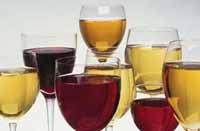Alcohol
 Alcoholic beverages can increase or decrease your blood sugar, depending on what you drink. Carbohydrate-containing alcoholic beverages like margaritas, rum & coke, sweet wines, beer or liqueurs can increase blood sugar levels. When you have a drink that has carbohydrate in it, this should be counted as part of the carbohydrate allowance you have at the meal or snack you are consuming it with. This will prevent blood sugars from increasing too much. On the other hand, consuming hard liquor such as rum, scotch, or vodka and dry red wines can lead to hypoglycemia (low blood sugar). How this occurs is explained below. Alcoholic beverages can increase or decrease your blood sugar, depending on what you drink. Carbohydrate-containing alcoholic beverages like margaritas, rum & coke, sweet wines, beer or liqueurs can increase blood sugar levels. When you have a drink that has carbohydrate in it, this should be counted as part of the carbohydrate allowance you have at the meal or snack you are consuming it with. This will prevent blood sugars from increasing too much. On the other hand, consuming hard liquor such as rum, scotch, or vodka and dry red wines can lead to hypoglycemia (low blood sugar). How this occurs is explained below.
Once absorbed, alcohol is sent to the liver. Alcohol is broken down by the liver and is used only for energy or is stored as fat. It cannot be converted to glucose or protein. While the liver handles the alcohol, it is unable to react to lower blood sugar levels. In other words, it cannot send sugar into the blood if the blood sugar gets too low. As a result, alcohol can lead to hypoglycemia. Alcohol-related hypoglycemia is more likely to occur if you:
- Are taking insulin or sulfonylureas (a type of diabetes medication)
- Drank more than a moderate amount of alcohol (more than 1-2 drinks)
- Drank on an empty stomach or ate less carbohydrate than usual
- Exercised recently
The hypoglycemia that results from alcohol consumption is especially dangerous if it occurs in a person who has had too much to drink. The physical and mental affects of too much alcohol can mimic those of hypoglycemia. These could include slurring of speech and an unsteady gait when walking. For this reason, hypoglycemia may not be promptly treated and can lead to a serious situation.
How do you fit alcohol in safely? 
- Limit the amount you drink. If you are male, drink no more than two drinks a day; if you are female, limit to one drink a day. A drink is: 5 ounces wine, 12 ounces beer or 1-1/2 ounces of hard liquor (such as vodka, scotch, gin, rum).
- Drink alcohol with or after a meal, not on an empty stomach. You may even need to eat some carbohydrate at bedtime to prevent nighttime low blood sugar.
- Avoid alcohol after strenuous exercise.
- Check your blood sugar every few hours when you are drinking to see how alcohol affects you.
- Make sure your friends know you have diabetes, and can help you in treating a low blood sugar if needed.
- Always wear a diabetes identification bracelet or necklace.
- If your diabetes is in poor control, it's best to avoid alcohol for now. Talk with your doctor about if and when it's safe to include alcohol in your routine.
- If you are taking either Diabinese or Glucophage, you should discuss how to fit alcohol into your diet with your doctor first.
Questions?
For more information on how to fit alcohol into your meal plan, see your dietitian or doctor.
 Continue Continue 
|





